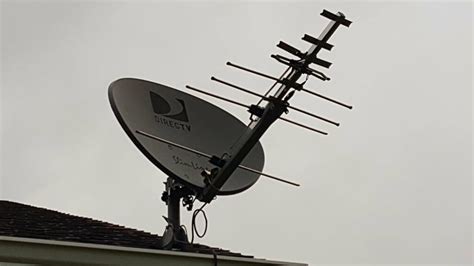Types of DTV Antennas
There are several types of DTV antennas available in the market, each with its own advantages and disadvantages. The main types include:
1. Indoor Antennas
Indoor antennas are compact and easy to set up, making them ideal for apartments or homes where outdoor installation is not possible. They are generally less powerful than outdoor antennas and are best suited for areas with strong signal reception.
a. Flat or Panel Antennas
Flat or panel antennas are thin, rectangular antennas that can be mounted on a wall or placed on a flat surface. They are directional, meaning they need to be pointed towards the broadcast towers for optimal reception.
b. Whip Antennas
Whip antennas are simple, telescopic antennas that can be extended or retracted. They are omnidirectional, meaning they can receive signals from all directions, but they have a limited range compared to other types of antennas.
2. Outdoor Antennas
Outdoor antennas are more powerful than indoor antennas and are ideal for areas with weak signal reception or for those who live far from broadcast towers. They require more installation effort but offer better performance.
a. Yagi Antennas
Yagi antennas, also known as directional antennas, consist of a long boom with multiple elements perpendicular to it. They are highly directional and must be pointed precisely towards the broadcast towers for the best reception.
b. Multi-directional Antennas
Multi-directional antennas, such as the bowtie or loop antennas, can receive signals from various directions without the need for precise aiming. They are less powerful than Yagi antennas but offer more flexibility in terms of installation.
Factors Affecting DTV Antenna Reception
Several factors can impact the performance of your DTV antenna:
- Distance from broadcast towers
- Terrain and obstacles (mountains, buildings, trees)
- Antenna type and quality
- Signal strength and interference
To determine the best type of antenna for your location, consult the following table:
| Distance from Towers | Terrain | Recommended Antenna Type |
|---|---|---|
| Less than 10 miles | Flat, unobstructed | Indoor (flat or whip) |
| 10-20 miles | Some hills or trees | Indoor (amplified) or outdoor (multi-directional) |
| 20-30 miles | Hilly or urban areas | Outdoor (Yagi or multi-directional) |
| More than 30 miles | Mountainous or remote | Outdoor (Yagi with amplifier) |
Installing a DTV Antenna
Installing a DTV antenna involves the following steps:
- Choose the appropriate antenna type based on your location and reception needs.
- Find the best location for your antenna, such as a high point on your roof or an unobstructed window.
- Assemble the antenna according to the manufacturer’s instructions.
- Connect the antenna to your TV or converter box using a coaxial cable.
- Scan for available channels on your TV or converter box.
- Fine-tune the antenna’s position for optimal reception.
For outdoor antennas, ensure that the installation is secure and grounded to protect against lightning strikes and other electrical hazards.

How to Make a DTV Antenna
If you’re feeling crafty, you can make your own DTV antenna using simple materials. Here’s a step-by-step guide:
Materials Needed
- 8 coat hangers
- Pliers
- Measuring tape
- Screwdriver
- Coaxial cable with F-connector
- Matching transformer (300 ohm to 75 ohm)
- Optional: Reflector material (e.g., aluminum foil)
Instructions
- Straighten the coat hangers and measure them to the following lengths:
- 2 pieces: 22 inches
- 2 pieces: 18 inches
- 4 pieces: 14 inches
- Bend each piece into a V-shape at the center.
- Arrange the V-shaped elements in a crisscross pattern, with the 22-inch pieces at the center, followed by the 18-inch pieces, and the 14-inch pieces on the outside.
- Secure the elements together at the center using pliers.
- Attach the matching transformer to the center of the antenna, connecting the 300-ohm side to the antenna elements and the 75-ohm side to the coaxial cable.
- Optional: Create a reflector by placing aluminum foil or another reflective material behind the antenna elements.
- Connect the coaxial cable to your TV or converter box and scan for channels.
While homemade antennas may not perform as well as commercial ones, they can be a fun and educational project.
FAQ
-
Q: Can I use an old analog TV antenna for DTV reception?
A: While some old antennas may work, it’s recommended to use a newer antenna designed specifically for DTV signals, as they are optimized for the frequencies used by digital broadcasts. -
Q: Do I need an amplifier for my DTV antenna?
A: An amplifier can help boost weak signals, but it’s not always necessary. If you live close to broadcast towers and have a strong signal, an amplifier may actually worsen reception by overloading the signal. -
Q: Can I use a DTV antenna with multiple TVs?
A: Yes, you can use a splitter to connect a single antenna to multiple TVs. However, keep in mind that splitting the signal may weaken it, so you might need an amplifier to compensate. -
Q: How do I know which direction to point my antenna?
A: Use online resources such as AntennaWeb or TVFool to generate a report showing the locations of broadcast towers relative to your address. Point your antenna towards the towers for the channels you want to receive. -
Q: Can I use a DTV antenna for FM Radio reception?
A: While some DTV antennas may be able to pick up FM radio signals, it’s best to use a dedicated FM antenna for optimal radio reception.
In conclusion, DTV antennas offer an affordable and effective way to access free over-the-air television. By understanding the different types of antennas, factors affecting reception, and proper installation techniques, you can enjoy high-quality digital TV programming without the need for costly subscriptions. And if you’re up for a challenge, you can even try making your own antenna using simple materials.

No responses yet